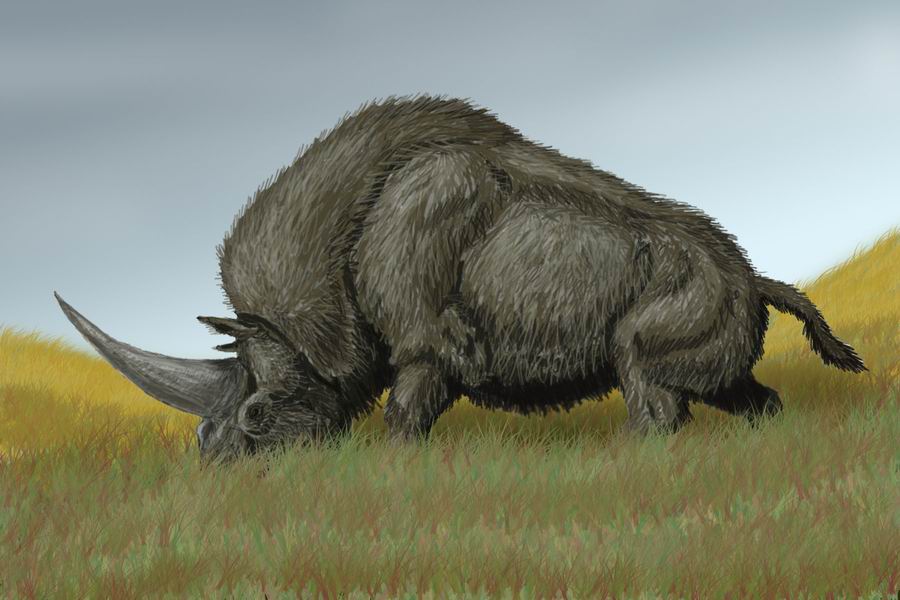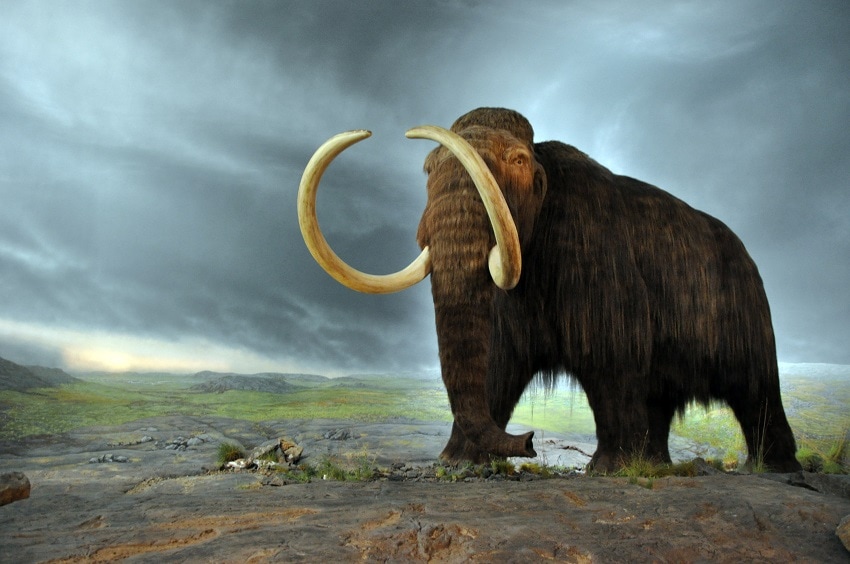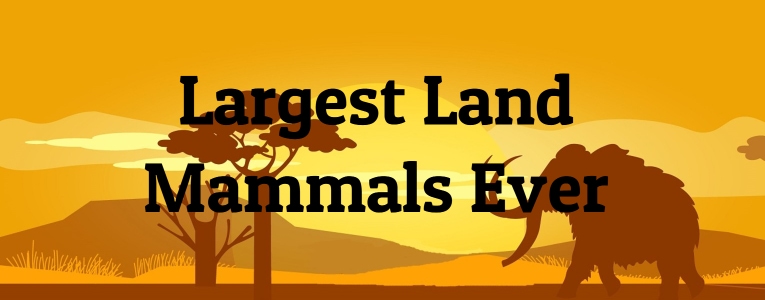-
Megatherium
Habitat: South America
Time Period Lived: Early Pliocene to end of Pleistocene (5 million to 8,000 years ago)
Scientific Name: Various but best known species is Megatherium americanum

Source: Wikimedia Commons via Ballista
Megatherium were giant ground sloths and the ancestors of modern-day tree sloths. Unlike their modern counterparts, which only weigh about 5 kilograms (11 pounds), Megatherium weighed between 3 to 4 metric tons (6,613.87 to 8,818.49 pounds). When Megatherium stood on its hind legs it was 3.5 meters (12 feet) tall.
There were a few various species of Megatherium, but the one species that we have the most information about is Megatherium americanum, which lived in South America, primarily in what is now Argentina, Uruguay, and Bolivia.
Did You Know?
Our ancestors may have eaten Megatherium as scientists have uncovered fossils with cut marks on them, which were most likely made by human tools and weapons.
-
Elasmotherium sibiricum
Habitat: Eastern Europe and Central Asia
Time Period Lived: Late Pliocene to early Pleistocene (2.6 million to 39,000 years ago)
Scientific Name: Elasmotherium sibiricum

Source: Wikimedia Commons via DiBgd
The Elasmotherium sibiricum is an extinct species of horned rhinoceros that is known as the “Giant Siberian Unicorn” because of its prominent horn. Elasmotherium sibiricum was almost as large as a Woolly Mammoth and is estimated to have weighed up to 4.5 metric tons (9,920.8 pounds). Also like the Woolly Mammoth, Elasmotherium sibiricum was covered in long hair.
For many years, scientists believed that Elasmotherium sibiricum had died out between 100,000 to 200,000 years ago, but a skull discovered in 2016 was dated to only 29,000 years ago. This means that Elasmotherium sibiricum was alive during the same time as Neanderthals and early modern humans.
Did You Know?
Elasmotherium sibiricum was one of 250 species of rhinoceros alive at the time. Today, there are just five species of rhinos left in the world.
-
Asian Elephant
Habitat: Indian Subcontinent and Southeast Asia from India and Nepal in the west to Borneo in the south
Time Period Lived: Present
Scientific Name: Elephas maximus

Source: Wikimedia Commons via Vpad236
Asian Elephants are the closest living relatives to the Woolly Mammoth, but aren’t quite as large. However, Asian Elephants are still some of the largest existing mammals in the world and can weigh between 2.25 to 5.5 metric tons (4,960.4 to 12,125.4 pounds). On average, Asian Elephants stand 6 to 12 feet (1.8 to 3.8 meters) tall at the shoulder.
Asian Elephants are fairly easy to domesticate and have been used by humans for thousands of years. People use Asian Elephants to move heavy objects, to carry humans and cargo, and even to wage war.
Did You Know?
Unlike African Elephants, Asian Elephants tend to have smaller tusks, which are called tushes. Only some male Asian Elephants develop large, prominent tusks like their African counterparts.
-
African Bush Elephant
Habitat: Sub-Saharan Africa (Kenya, Tanzania, Botswana, Zimbabwe, Namibia, and Angola)
Time Period Lived: Present
Scientific Name: Loxodonta africana

Source: Wikimedia Commons via Gorgo
The African Bush Elephant is currently the largest living land mammal in the world and is the bigger of the two African Elephant species. African Bush Elephants weigh between 4 to 7 metric tons (8,818.5 to 15,432.4 pounds). Male African Bush Elephants can reach up to 3.5 meters (11.5 feet) in height while females can be as tall as 3 meters (9.8 feet).
African Bush Elephants live in Sub-Saharan Africa, primarily in Kenya, Tanzania, Botswana, Zimbabwe, Namibia, and Angola. To go along with their large bodies, African Bush Elephants have massive tusks that are 2.5 meters (8.2 feet) in length and weigh between 50 to 100 pounds (22.7 to 45.36 kilograms).
Did You Know?
The African Bush Elephant’s trunk has 100,000 different muscles and is used for grabbing, drinking, breathing, smelling, and trumpeting.
-
Woolly Mammoth
Habitat: northern Asia, many parts of Europe, and northern part of North America
Time Period Lived: Pleistocene (600,000 – 370,000 years ago)
Scientific Name: Mammuthus primigenius

Source: Wikimedia Commons via Flying Puffin
The famous Woolly Mammoth was the smallest of all known mammoths, but was still a massive animal. Woolly Mammoths weighed up to 6 metric tons (13,227.7 pounds) and were 4 meters (13 feet) tall. In the past, Woolly Mammoths were abundant and roamed the Earth from northern Asia all the way to the northern parts of North America.
Although Woolly Mammoths lived a long time ago, they only went extinct about 4,000 years ago. In recent years, the scientific community has revealed that they may be able to resurrect the Woolly Mammoth from extinction.
Did You Know?
Woolly Mammoth hair could reach a length of 1 meter (3 feet).
-
Steppe Mammoth
Habitat: Northern Eurasia
Time Period Lived: Pleistocene (600,000 – 370,000 years ago)
Scientific Name: Mammuthus trogontherii

Source: Wikimedia Commons via Altes
The Steppe Mammoth was the largest of the known mammoth species and weighed between 9 to 14.3 metric tons (19,841.6 to 31,526 pounds). The Steppe Mammoth is the predecessor to the more famous woolly mammoth and lived in the cold parts of ancient Eurasia. Not only was the Steppe Mammoth very heavy, it was also tall and had a height between 4 to 4.5 meters (13.1 to 14.8 feet).
In 2015, scientists discovered an almost complete Steppe Mammoth skeleton in Russia. The Steppe Mammoth is estimated to be over 100,000 years old and was a male that died at approximately 45 years of age.
Did You Know?
The Steppe Mammoth’s tusks were 2.5 meters (8.2 feet) in length and a pair discovered in 2015 weighed a total of 150 kilograms (330.69 pounds).
-
Indricotherium (Paraceratherium)
Habitat: Plains of Eurasia
Time Period Lived: Oligocene (35 – 20 million years ago)
Scientific Name: Paraceratherium transouralicum

Source: Wikimedia Commons via ABelov2014
Indricotherium or Paraceratherium is an extinct species of hornless rhinoceros that is believed to be the largest land mammal that ever lived. Living in the plains of Eurasia between 20 to 35 million years ago, the Indricotherium is estimated to have weighed between 15 to 20 metric tons (33,000 to 44,000 lbs).
In addition to being quite heavy, Indricotherium was also tall and was about 40 feet (12.2 meters) long. Unlike modern rhinos, Indricotherium had a relatively long neck and thin legs.
Did You Know?
When Indricotherium fossils were first discovered, paleontologists believed that it was much larger, up to 60,000 pounds (27.2 metric tons). However, scientists largely agree that Indricotherium could not have weighed more than 44,000 pounds (20 metric tons).
